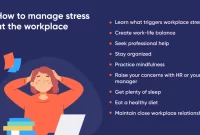Managing workplace stress is essential for employees to maintain their well-being. This article explores effective strategies that employees can implement to alleviate stress, promoting a healthier and more productive work environment.
Practicing Mindfulness and Meditation
In the fast-paced world of today, workplace stress has become a common issue for many employees. Among the various strategies to manage this stress, practicing mindfulness and meditation has gained significant popularity. Mindfulness involves paying attention to the present moment, without judgment or attachment to passing thoughts or emotions. Meditation, on the other hand, is a practice that aims to train the mind to focus and achieve mental clarity.
By incorporating mindfulness and meditation into your daily routine, you can effectively manage workplace stress. Here are a few ways you can do so:
-
Start with short meditation sessions:
Begin with short meditation sessions, around 5-10 minutes a day. Find a quiet place where you can sit comfortably and focus on your breath or repeat a mantra. As you become more experienced, you can gradually increase the duration of your sessions.
-
Practice mindful breaks:
Take short breaks throughout the day to practice mindfulness. Engage in activities that bring your focus to the present moment, such as taking a walk in nature, practicing deep breathing exercises, or simply closing your eyes and observing your thoughts and sensations without judgment.
-
Use mindfulness in daily tasks:
Incorporate mindfulness into your daily tasks at work. Focus on one task at a time, giving it your full attention. Avoid multitasking, as it can lead to stress and decreased productivity.
-
Attend mindfulness and meditation workshops:
Look out for workshops or classes on mindfulness and meditation in your area. These sessions can provide guidance and support as you learn and deepen your practice.
Overall, practicing mindfulness and meditation can be an effective tool in managing workplace stress. By incorporating these strategies into your daily routine, you can cultivate a sense of calm and clarity, leading to improved well-being and productivity.
Setting Realistic Work-Life Boundaries
In today’s fast-paced work environment, managing workplace stress has become increasingly important for employees. One effective strategy to reduce stress is by setting realistic work-life boundaries. By establishing clear boundaries between work and personal life, individuals can achieve a healthier work-life balance and improve their overall well-being.
Here are some practical tips to help employees set realistic work-life boundaries:
1. Prioritize and Delegate
Identify your most important tasks and focus on those first. Delegate non-essential tasks to colleagues whenever possible. By prioritizing your workload, you can ensure that you’re not overwhelmed with excessive work demands, allowing you to have more time for personal activities.
2. Create a Daily Schedule
Plan your day in advance by creating a schedule. Set aside specific time blocks for work-related tasks and dedicate other blocks solely to personal activities. Stick to your schedule as much as possible, allowing for breaks and time to recharge.
3. Learn to Say No
Don’t be afraid to say no to additional work or commitments that will encroach upon your personal time. Be assertive in communicating your limitations and make it clear that you value your personal life and well-being.
4. Establish Work-Free Zones
Create designated areas or time periods where work-related activities are strictly off-limits. Whether it’s a particular room in your house or certain hours of the day, having work-free zones helps create a clear separation between work and personal life.
5. Disconnect from Technology
Set boundaries with technology by disconnecting from work-related emails and notifications during non-work hours. Establish specific times to check and respond to work communications, allowing yourself uninterrupted personal time.
6. Seek Support from Colleagues
Reach out to your colleagues for support in managing workloads and setting boundaries. By fostering a supportive work culture where everyone respects each other’s personal time, employees can collectively reduce stress and promote work-life balance.
By implementing these strategies, employees can better manage workplace stress by setting realistic work-life boundaries. Remember, achieving a healthy work-life balance ultimately leads to increased productivity, improved mental well-being, and a happier, more fulfilled life.
Engaging in Regular Physical Exercise
Regular physical exercise is an effective strategy for managing workplace stress. It can provide numerous benefits for employees, both physically and mentally. Engaging in regular exercise can help reduce stress levels, boost mood, improve concentration, and increase overall productivity at work.
One way to incorporate exercise into the daily routine is by taking short breaks throughout the workday to engage in physical activity. This can include going for a brisk walk, doing stretching exercises, or even participating in a quick workout. These breaks can help reduce stress and improve focus, allowing employees to return to their tasks with renewed energy and mental clarity.
Another option for managing workplace stress through exercise is by joining company-sponsored fitness programs or initiatives. Many organizations offer gym memberships, fitness classes, or sports activities to encourage employees to stay active. Taking advantage of these opportunities can not only help reduce stress but also foster a sense of camaraderie and teamwork among colleagues.
In addition to the immediate benefits, engaging in regular physical exercise can also have long-term effects on overall health and well-being. It can lower the risk of chronic diseases, improve cardiovascular health, and help maintain a healthy weight. These physical improvements can further contribute to reducing stress and improving overall quality of life.
Overall, incorporating regular physical exercise into the daily routine is a valuable strategy for managing workplace stress. By making exercise a priority, employees can experience improved well-being, increased productivity, and a better ability to cope with the demands of their jobs.
Conclusion
In conclusion, managing workplace stress is crucial for employees to maintain their well-being and productivity. By implementing strategies such as practicing self-care, seeking support, setting boundaries, and prioritizing tasks, employees can effectively cope with stress and create a healthier work environment.




